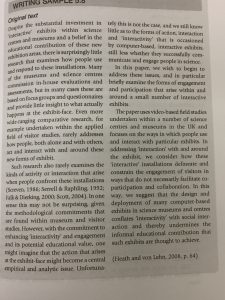Understanding rhetorical moves and metalanguage
Every academic writer makes rhetorical moves, for example, entering a debate, using evidence to support an argument, winding down to a conclusion, opening up a topic, and critiquing another writer’s argument. “Metalanguage” is the way authors talk about their writing, for example, “In this study, I will explore…” and this may vary by discipline. Explore the following exercises and tool to discover the moves and metalanguage in your discipline.
Analyze articles in your field(s)
In order to understand the moves in your discipline, try the following discovery exercise. Credit goes to Dr. Janet Sheppard for this idea:
Ask a research librarian to help you find the top three peer reviewed journals in your discipline. If you are working in more than one discipline, find three journals in each. Now look for two articles NOT related to your topic (so you don’t get too immersed in content) in each journal and analyze the structure of each one: What’s going on in the intro? Conclusion? How are headings used? Is there an abstract? Is there an “I,” and if so, how present is the writer and his or her voice? How does the author approach argument? Evidence? Data? Methodology? Once you analyze several articles, you’ll start to get a sense of what rhetorical moves the authors in your discipline(s) are making. This analysis will help you in your own writing.
Using sentence skeletons to claim authority
Thomson and Kamler (2016) suggest you pay attention to the “sentence skeletons” of other writers. They take the notion of sentence skeletons from Swales and Feak’s 1994 work. By looking at the bones of sentences written by experienced writers, you are able to see patterns and make those rhetorical moves explicit: “Remove the content words [to] reveal the structure or skeleton of moves” (p. 102). Here’s an example of an original text by Heath and von Lehn and the sentence skeletons that are left after the meat is removed (see pp. 102-103). See how the authority of the writer comes through in these moves:
Despite. . . , there is surprisingly little research that examines . . . Many . . . , but in many cases these are based on . . . and provide little insight to . . . Even more wide-ranging . . . research, for example . . . , rarely addresses . . . such research also rarely examines . . . In one sense this may not be surprising, given . . . However, with . . . , one might imagine that . . . Unfortunately this is not the case, and we still know little as to . . . , still less whether. . .
In this paper, we wish to begin to address these issues, and in particular briefly examine. . . The paper/ chapter uses. . . and focuses on the ways in which . . . In addressing. . . , we consider . . . In this way, we suggest that. . .
Don’t reinvent the wheel
The Academic Phrasebank: John Morley at the University of Manchester created this valuable resource for academic writers: “It aims to provide you with examples of some of the phraseological ‘nuts and bolts’ of writing organised according to the main sections of a research paper or dissertation.” Morley organizing the phrases by section and by purpose: so, for example, there are stems for being critical, for being cautious, and for signalling transitions. He is not specific about discipline, so you will need to be alert to whether his phrases will work in your discipline (analyze articles in your field to discover these disciplinary differences). Check out the phrasebank and “borrow” some phrases. You won’t be charged interest.
Resources
Swales, J., & Feak, C. (1994). Academic writing for graduate students: Essential tasks and skills. Ann Arbor, MI: University of Michigan Press.
Thomson, P., & Kamler, B. (2016). Detox your writing: Strategies for doctoral researchers. London, UK: Routledge. Now available as an e-book in the UVic library database.
Page written by Madeline Walker; last updated December 20, 2016.
